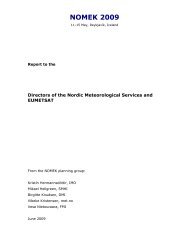International Symposium on Mitigative Measures against Snow ...
International Symposium on Mitigative Measures against Snow ...
International Symposium on Mitigative Measures against Snow ...
Create successful ePaper yourself
Turn your PDF publications into a flip-book with our unique Google optimized e-Paper software.
<str<strong>on</strong>g>Internati<strong>on</strong>al</str<strong>on</strong>g> <str<strong>on</strong>g>Symposium</str<strong>on</strong>g> <strong>on</strong> <strong>Mitigative</strong> <strong>Measures</strong> <strong>against</strong> <strong>Snow</strong> Avalanches<br />
Egilsstaðir, Iceland, March 11–14, 2008<br />
2. SNOW AVALANCHE LOADING<br />
The risks of snow avalanches falling al<strong>on</strong>g the line route were extensively investigated by<br />
avalanche specialists through examinati<strong>on</strong> of the area, analysis of meteorological data,<br />
reviewing historical evidences of avalanches in the regi<strong>on</strong>, modelling snow drift and calculating<br />
runout distances and avalanche velocities see Jónss<strong>on</strong> and others (2005) and Margreth<br />
and Ammann (2004). Avalanche risk and loading was evaluated for each tower site.<br />
The basic force at a given height <strong>on</strong> an obstacle caused by an avalanche can be expressed as:<br />
F = p · Cf · A = (0,5 · ρ · V 2 ) · Cf · A<br />
where Cf is a unit force coefficient, p is dynamic pressure, A is the projecti<strong>on</strong> of the obstacle<br />
area perpendicular to the avalanche load directi<strong>on</strong>, ρ is density and V is avalanche velocity.<br />
The avalanche loading is divided into three layers; a<br />
dense avalanche core, a saltati<strong>on</strong> layer and a snow<br />
cloud. The saltati<strong>on</strong> layer is an intermediate layer between<br />
the fairly rigidly flowing dense core and the<br />
turbulent snow cloud, physically representing the<br />
transiti<strong>on</strong> between the two. Rolling particles <strong>on</strong> top<br />
of the core can thus be found at the bottom of the saltati<strong>on</strong><br />
layer, whereas the lesser dense upper part of it<br />
more resembles a snow cloud. Density and flow<br />
velocity are the two variables that govern the avalanche<br />
pressure. Given a fixed velocity in all layers at a<br />
given site, the pressure becomes a functi<strong>on</strong> of density.<br />
Intuitively, the pressure reaches its highest value<br />
within the dense core and subsequently reduces with<br />
Figure 2: Definiti<strong>on</strong> of snow avalanche loading.<br />
increased elevati<strong>on</strong>. After accounting for the presence<br />
of snow layers and previous avalanches, the upper boundary of the avalanche core reached up to 5 −<br />
8.5 m above ground level. The form of the pressure distributi<strong>on</strong> diagram is shown in Figure 2.<br />
Figure 3 shows the distributi<strong>on</strong> of towers in terms of avalanche core pressure, excluding form factor.<br />
The corresp<strong>on</strong>ding avalanche velocities lie in the range of 5 − 49 m/s for the towers in FL3 and FL4.<br />
Following parameters were given for each tower site: thickness of existing snow layer and<br />
previous avalanche, thickness of avalanche core, thickness of snow cloud, avalanche velocity<br />
and directi<strong>on</strong>. Same parameters were given for each span between towers. Some basic numbers<br />
defining the avalanche loading are as follows:<br />
• Avalanche velocity (V): 5 – 49 m/s<br />
• Density of dense core (ρ): 300 kg/m<br />
170 Towers for snow avalanches in 420 kV transmissi<strong>on</strong> lines in Iceland<br />
3<br />
• Thickness of core: 2 – 3 m<br />
• Upper boundary of core (due to snow <strong>on</strong><br />
ground and previous avalanches): 5 – 8.5 m<br />
• Density at boundary between saltati<strong>on</strong> layer<br />
and snow cloud: 15 kg/m 3<br />
18<br />
16<br />
14<br />
12<br />
10<br />
8<br />
6<br />
4<br />
2<br />
0<br />
• Thickness of saltati<strong>on</strong> layer: 0.10 sec. * V<br />
0 - 50 50 - 100 100 - 150 150 - 200 200 - 250 250 - 300<br />
Core pressure [kPa]<br />
300 - 350 350 - 400<br />
•<br />
•<br />
Finite pressure at top of snow cloud: 150 Pa<br />
Thickness of snow cloud = 15 – 35 m<br />
Figure 3: Distributi<strong>on</strong> of core pressure.<br />
• Unit force coefficient Cf = 1.5 for circular and elliptical tower shapes within the dense<br />
core and saltati<strong>on</strong> layer, Cf = 1.2 in the snow cloud.<br />
Towers [qua.]











